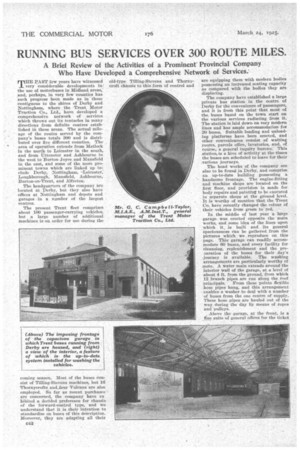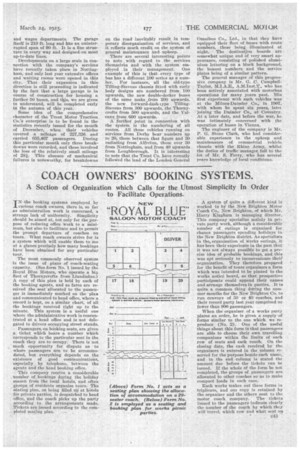RUNNING BUS SERVICES OVER 300 •ROUTE MILES.
Page 26

Page 27

If you've noticed an error in this article please click here to report it so we can fix it.
A Brief Review of the Activities of a Prominent' Provincial Company Who Have Developed a Comprehensive Network of Services.'
THE...kST few years have witnessed very considerable developments in the use of motorbuses in Midland. areas; .and, perhaps, in very few counties has such progress been made as in those contiguous to the shires of Derby and Nottingham, where the Trent Motor Traction Co., Ltd., have developed a comprehensive network of services which throws out its tentacles in many directions from definite centres established in these areas. The actual mileage of the routes served by the company's buses totals NO and is distributed over five different counties. The area of operation extends from Matlock in the north to Leicester in the south, and from Uttoxeter and Ashbourne in the west to Burton Joyce and Mansfield in the east, and some of the more prominent towns which are linked up include Derby, Nottingham, -Leicester: Loughborough, Mansfield, Ashbourne, Burton-on-Trent, and Alfreton.
The headquarters of the company are located at Derby, but they also have offices at Nottingham and depots and garages in a mamber of the largest centres.
The present Trent fleet comprises about 100 passenger-carrying vehicles, but a large number of additional machines is on order for UBC during the
coming season. Most of the buses congist of Tilling-Stevens machines, but 16 Thornyerofts and lour Fuleans are also employed. So far as recent purchases are concerned, the company have ex hibited a decided preference for chassis of the forward-control type, and we understand that it is their intention to standardize on buses of this description. Moreover, they are adapting all their C42 old-type Tilling-Stevens and Thornycroft chassis to this form of control and are equipping them with modern bodies possessing an increased seating capacity as compared with the bodies they are displacing.
The company have established a large private bus station in the centre of Derby for the convenience of passengers, and it is from this point that most of the buses based on the town start on the various services radiating from it. The station is laid down on very modern lines and has ample accommodation for 20 buses. Suitabre loading and unload= jug platforms have been erected, and other conveniences consist of waiting rooms, parcels office, lavatories, and, of course, a general inquiry bureau. This station is a hive of activity at the times the buses are scheduled to leave for their ,various journeys.
The head works of the company are also to be fount]. in Derby, and comprise an up-to-date building possessing a handsome frontage. The engine-fitting and machine shops are located on the first floor, and provision is made for body repairs and painting to be executed in separate shops at the ground level. It is worthy of mention that the Trent Co. have recently changed the colour Of their vehicles from green tore& 'In the middle of last year a large garage was erected opposite the main works, and some idea of the lines upon which it is built and its general spaciousness can be gathered from the pictures which we reproduce on this page. Thisgarage can readily accommodate 60 buses, and every facility for cleansing, replenishment and the preparation of the buses for their day's journey is available. The washing arrangements are particularly worthy of :note. A water main extends around the interior wall of the garage, at a level of about 4 ft. from the ground, from which 12 branch pipes are run along the roof Principals. From these points flexible hose pipes hang, and this arrangement -enables a washer to deal with a number of buses from the one centre of supply. These hose .pipes are hauled out of the way during the day liy means of ropes and pulleys.
Above the garage, at the front, is a fine suite of general offices for the ticket and wages departments. The garage itself is 210 ft. long and has an uninterrupted span of 90 ft. It is a fine structure in every way and designed on most up-to-date lines.
Developments on a large scale in connection with the company's services have recently taken place in Nottingham, and only last year extensive offices and waiting rooms were opened in this City. That their expansion in this direction is still proceeding is indicated by the fact that a large garage is in course of construction for housing a further 50 buses, and this, we are given to understand, will be 'completed early in the autumn of this year.
Some idea of the comprehensive character of the Trent Motor Traction Co.'s enterprise is to be found in the statistics recently issued for the month of December, when their vehicles covered a mileage of 227,326 and carried 655,467 passengers. During this .particular month only three breakdowns were recorded, and these involved the loss of the relatively small mileage of 28i. This absence of mechanical failures is noteworthy, for breakdowns
on the road inevitably result in temporary disorganization of services, and it reflects much credit on the system of general maintenance and upkeep.
There are several interesting points to note with regard to the services themselves and with the system employed in their management. One example of this is that every type of bus has a different 100 series as a num.ber. For instance, all the old-type Tilling-Stevens chassis fitted with early body designs are numbered from 100 upwards, the new double-decker buses of the same make Jrcim 200 upwards, the new forward-dash type TillingStevens from 300 upwards, the Thornycrofts from 500 upwards, and the Vulcans. from GOO upwards.
A further point in connection with the system is the numbering of all routes. All those vehicles running on services from Derby bear numbers up to 20, those between that figure and 30 radiating from Alfrelon, those over 30 from Nottingham, and from 40 upwards from Longhborough. It is interesting to note that the Trent Co. have recently followed the lead of the London General Omnibus Co., Ltd., in that they have equipped their fleet of buses with route numbers, these being illuminated at night. The destinatlon, hoards are somewhat unique and of very smart appearance, consisting of polished aluminium lettering on a black background, the bonnet numbers and the service plates being of a similar pattern.
The general manager of this progressive company is Mr. G. C. CampbellTaylor, 111.I.A.E., .A.M.Inst.T., who has been actively associated with motorbus operations for many years past. His first experience with such vehicles was at the Milnes-Daffialer Co., in 1907, with whom he spent six years, latei joining the Daimler Co., at Coventry. At a later date, and before the war, he was intimately concerned with the operation of buses in Vienna.
The engineer of the company is Mr. F. G. Stone Clark, who had considerable experience in the upkeep and maintenance of commercial vehicle chassis with the Rhine Army, whilst the duties of traffic manager, fall to the lot of Mr. S. Perry, who hatt several years knowledge of local conditions.
























































